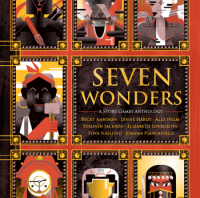When the Dark is Gone
Designed by Becky Annison and Published by Pelgrane Press as part of the 7 Wonders Anthology Available at the Pelgrane Press site.
Pelgrane Press has recently published a fantastic anthology of story games, titled “Seven Wonders”. I will be preparing short reviews of all seven games within the book as part of my “Indie Gems” series. The first of these is a game by Becky Annison, titled “When the Dark is Gone”.
This game starts with an excellent summary that I will steal outright.
Imagine the children in The Lion, the Witch and the Wardrobe. They visited a magical land, fought battles alongside talking animals and centaurs, and won a war against a powerful and evil enemy. Then they returned home, no-one believed them, and they were back to war time rations and maths homework.
What does that feel like? How did they live with the memories of what they saw? Did they end up in therapy?
This is a game about children who went through a fantastic ordeal in their youth which traumatized them. It’s an emotionally gripping and ruthlessly compelling game about a group of broken people, trying to fix themselves. Each player portrays one adult with a psychological disorder stemming from their childhood heroics. The GM plays the role of the Therapist, charged both with the safety of the players and in encouraging productive exploration of the character’s issues.
The game is only about 40 pages of content, but it offers some of the most robust GM guidance and support that I have seen in any game. It explains the role of the Therapist to listen and reflect back, and not to judge or create. It asks the GM to establish an atmosphere, ask open questions, allow players to choose their story, share spotlight time, maintain the pace of the game, and maintain the focus on the characters. It teaches participants on how to improvise, incorporating the advice from works such as Play Unsafe, Impro, and variety of other larp sources. Last, but most important, it offers tools for safety so that the obvious sensitive topics can be addressed.
For players, this seems to produce very emotionally rich gameplay. Each character is defined by a psychological disorder, two cornerstone relationships with other player characters, dark secrets associated with those relationships, and one redeeming feature. It’s a simple list of ingredients, but they do an excellent job of creating a cohesive and dysfunctional group of adults, bound to each other by their common trauma. The game tells you that your characters is hurting, and asks you to explore what part of their childhood fantasy ordeal caused this pain. It offers a chance for catharsis and healing, and the emotional Bleed off this game should be significant.
I look forward to bringing this to the table. I just need to acquire some Turkish Delights first.

